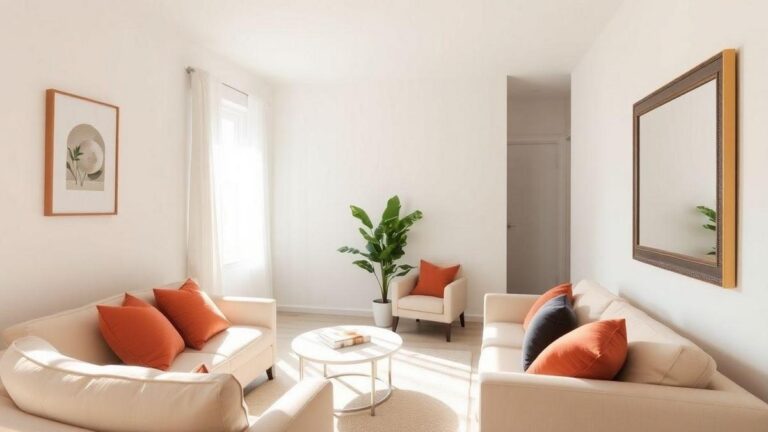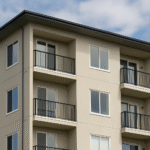
Color schemes can transform a room from drab to fab! In this article, we will explore the magic of soft neutrals and how they dance with bold accents. Discover how color blocking can create cozy zones in a studio. With clever tricks using paint and wallpaper, you will learn to add depth and interest that makes small spaces feel bigger. Get ready for colorful inspiration!
Soft Neutrals vs. Bold Accents: Finding the Right Balance
When it comes to color schemes, the dance between soft neutrals and bold accents can feel like a balancing act. Picture a canvas where gentle tones meet vibrant splashes; it’s a visual feast that can transform any space. The key lies in knowing how to blend these elements to create harmony.

Soft Neutrals
Soft neutrals are like a gentle whisper. They bring a sense of calm and serenity. Think of colors like beige, soft gray, and pale pastels. These shades can make a room feel spacious and inviting, serving as a perfect backdrop for bolder colors.
Benefits of Soft Neutrals:
- Calming Atmosphere: They create a peaceful environment.
- Versatility: They pair well with almost any color, making them ideal for small apartments.
- Timelessness: They never go out of style.
Bold Accents
On the flip side, bold accents are like fireworks in the night sky. They grab attention and add personality. Colors such as deep blue, fiery red, or bright yellow can energize a space. When used wisely, they can bring life to a room without overwhelming it.
Benefits of Bold Accents:
- Visual Interest: They make a space feel dynamic.
- Personal Expression: They allow for creativity and uniqueness.
- Focus Points: They can highlight specific areas or features.
- Seguro Contra Incêndio Apartamento: Proteja Seu Lar com Tranquilidade

- Conheça a Planta Mais Querida das Hortas Medicinais e Seus Benefícios Incríveis

- 5 coisas que você nunca deve jogar no ralo – a 3ª é surpresa!

Finding the Right Balance
To strike the perfect balance, consider the mood and purpose of the space. Here’s a simple guide to help navigate this colorful journey:
| Room Type | Recommended Soft Neutrals | Suggested Bold Accents |
|---|---|---|
| Living Room | Light beige, soft taupe | Navy blue cushions, red artwork |
| Bedroom | Pale gray, soft lavender | Bright yellow throw, teal lamp |
| Kitchen | Cream, soft mint | Orange utensils, deep green plants |
By mixing soft neutrals with bold accents, a space can feel both cozy and lively. For instance, a living room painted in soft beige can be brought to life with navy blue cushions and a vibrant red piece of art. This combo creates depth and draws the eye.

Using Color Blocking to Define Zones in a Studio
Color blocking is a fantastic way to create distinct areas in a studio space. By using bold colors and different shades, you can easily set apart various zones for activities. Imagine a cozy reading nook surrounded by a warm yellow, while a vibrant blue defines the workspace. This method not only adds visual interest but also helps in organizing the space.
Why Use Color Blocking?
- Visual Clarity: Color blocking allows for clear boundaries. Each zone feels separate, making it easier to focus on the task at hand.
- Aesthetic Appeal: Bright colors can make a space feel lively and inviting, sparking creativity and motivation.
- Personal Expression: Different colors can reflect personal tastes, allowing you to choose hues that resonate with your personality.
How to Implement Color Blocking
To effectively use color blocking, follow these simple steps:
| Step | Action |
|---|---|
| 1 | Choose a Color Palette: Select a few colors that work well together. |
| 2 | Define Zones: Decide which areas need distinct colors. |
| 3 | Apply Colors: Use paint, wallpaper, or decor to add color to each zone. |
| 4 | Accessorize: Match furniture and decor items to the colors in each zone. |
Tips for Successful Color Blocking
- Start Small: If unsure, begin with a small area. This way, adjustments can be made without overwhelming the space.
- Balance is Key: Use a mix of colors. Too many bright shades can clash, while too few can feel dull.
- Test Samples: Before committing, try out paint samples. This helps in seeing how colors look in different lighting.
Real-Life Example
Take Sarah, for instance. She transformed her studio apartment by using color blocking. The kitchen area shines in fresh green, while her workspace is a calming soft blue. The living area features a cozy warm orange. This not only makes her space lively but also helps her switch gears when moving from one activity to another.
Tricks with Paint and Wallpaper to Add Depth and Interest
When it comes to transforming a space, paint and wallpaper are two of the most powerful tools in the decorator’s toolkit. They can breathe new life into a room, making it feel more inviting and lively. Here are some clever tricks to consider.
Play with Color Schemes
Using color schemes can dramatically change the feel of a room. Here are some ideas:
- Monochromatic Magic: Stick to one color but use different shades. This creates a harmonious look while adding depth.
- Contrasting Colors: Pair bold colors with neutrals. For example, a bright blue wall with soft white trim can make the blue pop.
- Accent Walls: Choose one wall to paint a different color. This draws the eye and adds interest without overwhelming the space.

Wallpaper Wonders
Wallpaper can be a game changer. Here’s how to make it work:
- Textured Wallpaper: Using textured wallpaper can add dimension. Think about a brick pattern or a subtle linen texture.
- Bold Patterns: Large floral or geometric designs can create a stunning focal point. Just be sure to balance it with simpler decor.
- Peel-and-Stick Options: These are perfect for renters or those who love change. They’re easy to apply and remove.
Combining Techniques
Why not mix paint and wallpaper? Here’s how:
| Technique | Description | Example |
|---|---|---|
| Painted Borders | Paint a border around wallpaper for definition. | A bright color around floral wallpaper. |
| Half-Wall Styles | Paint the lower half of the wall and wallpaper the top. | A solid color with a fun pattern above. |
| Layered Textures | Use both paint and textured wallpaper for interest. | A painted wall with a textured panel. |
Finishing Touches
Don’t forget the little things! Accessories can tie everything together. Consider adding:
- Artwork: Hang art that complements the color schemes.
- Mirrors: These can reflect light and make a space feel larger, enhancing the decor.
- Plants: Greenery adds life and can soften bold colors.
In the world of color schemes, the interplay between soft neutrals and bold accents creates a symphony of style that can elevate any small space. By understanding the benefits of each and mastering the art of color blocking, you can carve out cozy nooks and vibrant areas that not only serve a purpose but also tell a story. From the calming embrace of soft grays to the energetic burst of fiery reds, the right balance can transform a room from ordinary to extraordinary.
As you embark on your own colorful journey, remember that the magic lies in experimentation. So, roll up those sleeves, grab that paintbrush, and let your creativity flow! For more inspiring ideas and tips on making the most of your small space, be sure to check out more articles at Simple Small Space Living. Happy decorating!
Discover our Pinterest
[…] Use Light Colors: Paint the walls in soft, light shades like whites or pastels. This makes the room feel airy and open. For more on color choices, check out our color schemes guide. […]
[…] walls can bring a pop of color without overwhelming the space. Explore various color schemes to find the perfect […]
[…] Easy to Match: It goes well with almost any color scheme, making your decorating process smoother. For additional color scheme ideas, check out this resource. […]
[…] light colors to make your small restroom feel bigger. Consider exploring different color schemes that can enhance your […]
[…] that feels bright and cheerful instead of cramped and dark. For more on how to choose the right color schemes, check out this helpful […]